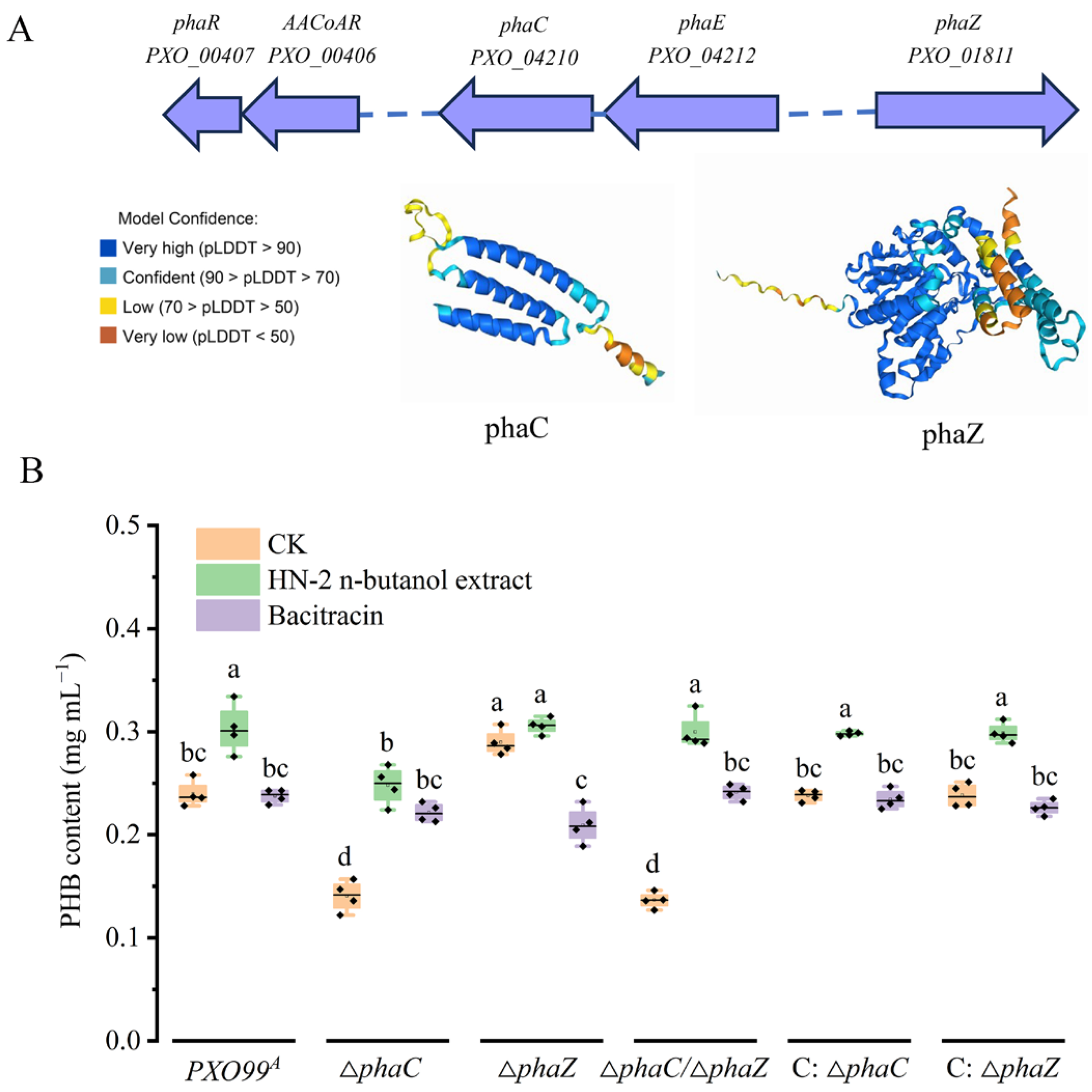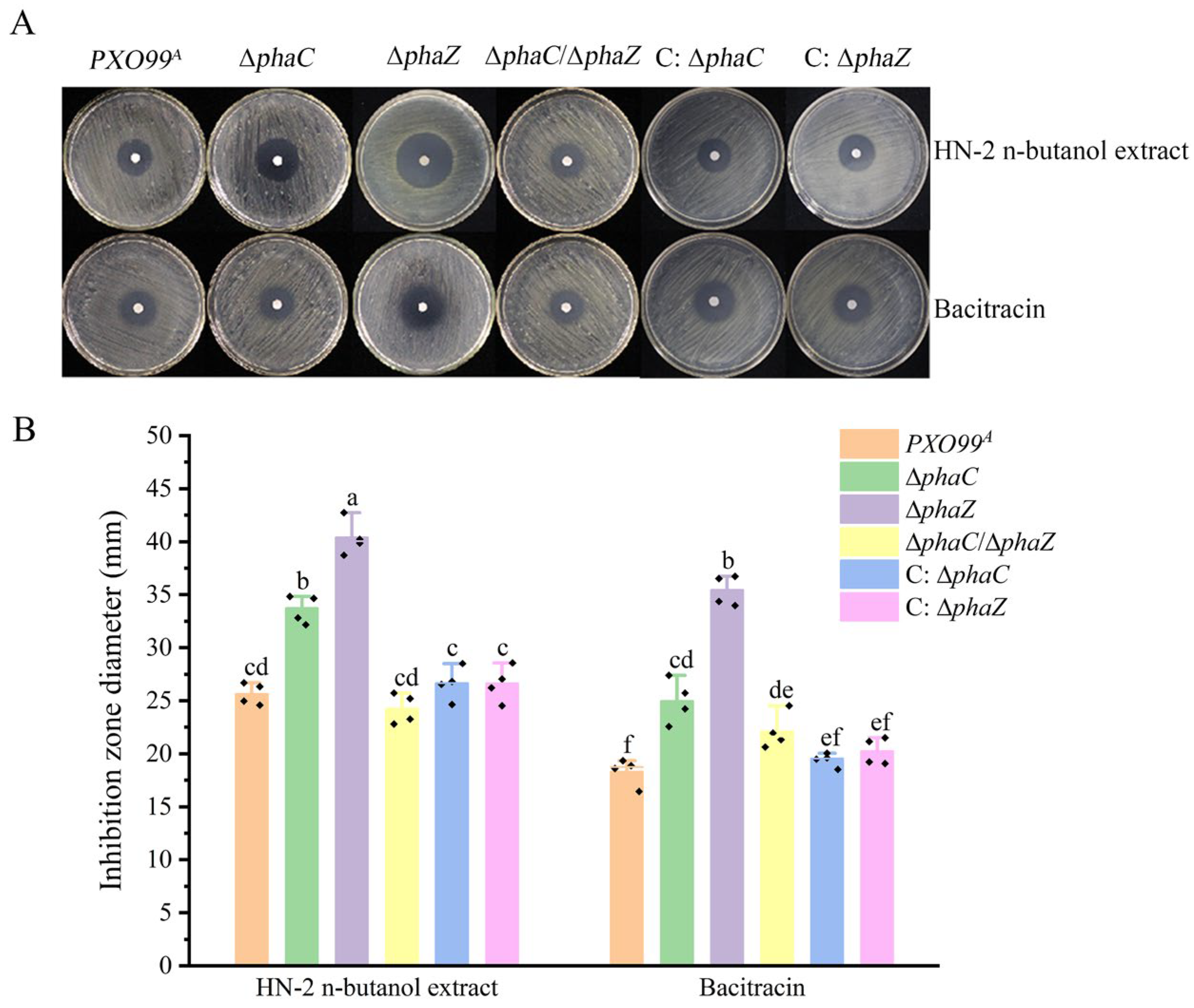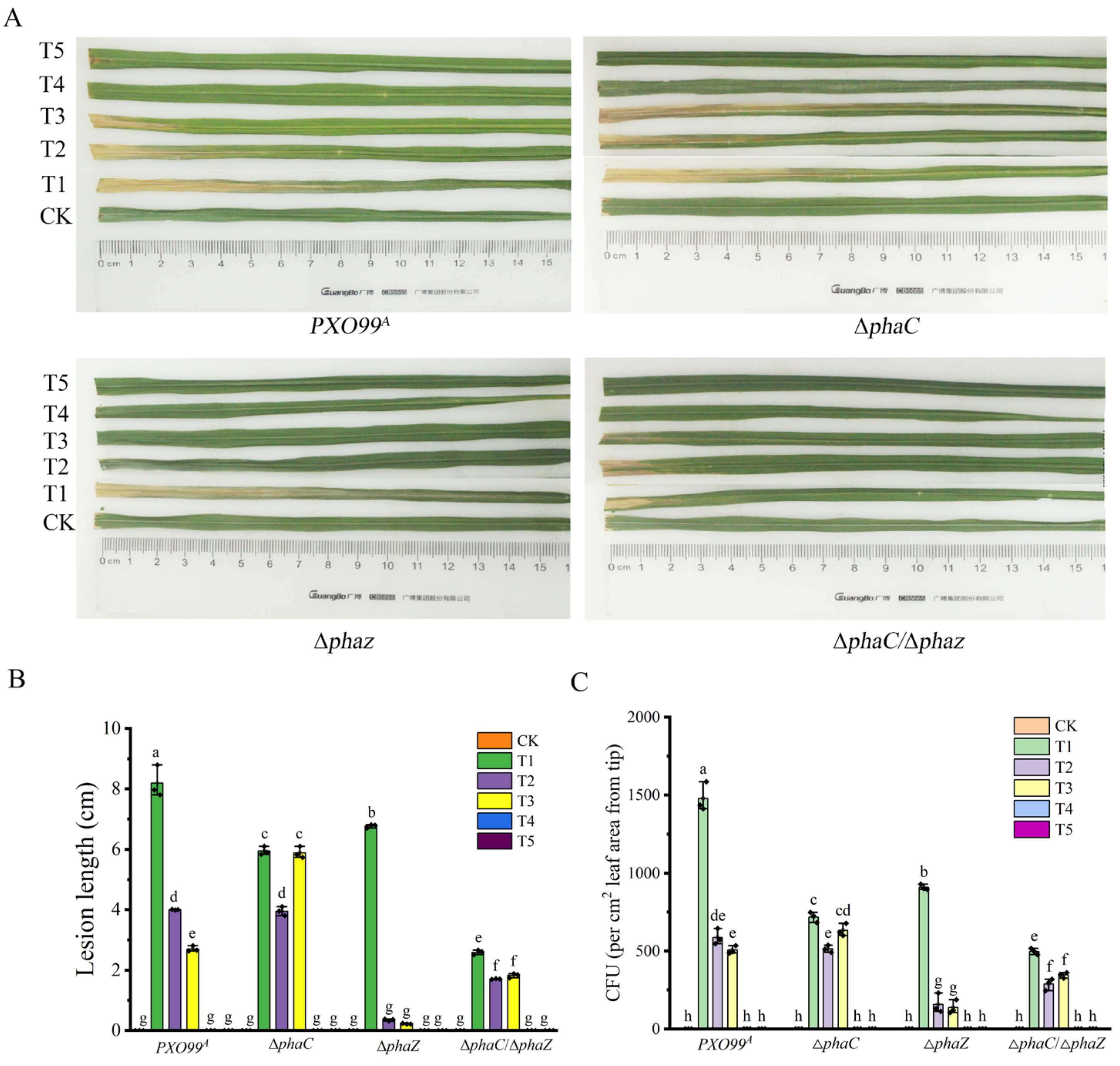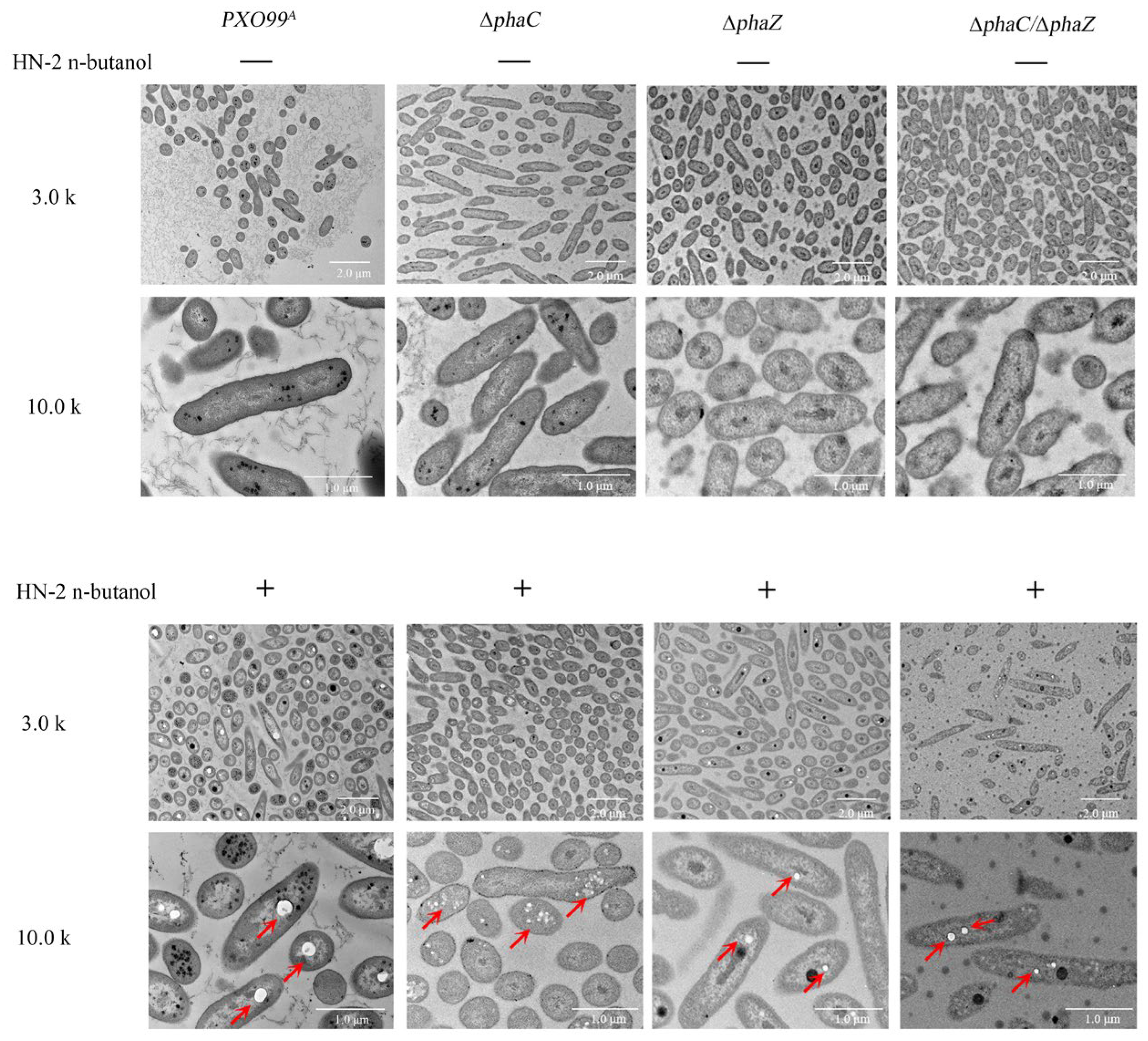Investigating Polyhydroxyalkanoate Synthesis for Insights into Drug Resistance in Xanthomonas oryzae pv. oryzae
Abstract
1. Introduction
2. Results
2.1. Characteristics of phaC and phaZ Gene Involved in Poly-3-Hydroxybutyrate (PHB) Synthesis in PXO99A
2.2. Loss of phaC/phaZ Reduced Xoo Drug Resistance to HN-2 n-Butanol Extract
2.3. Deletion of phaZ Reduced the Resistance of Xoo to the HN-2 n-Butanol Extract During Infection
2.4. Mutation of phaC/phaZ Accelerated Cells Damage in Xoo Caused by the HN-2 n-Butanol Extract
2.5. Loss of phaC/phaZ Increases Cell Membrane Sensitivity to the HN-2 n-Butanol Extract in Xoo
2.6. Mutation of phaC and phaZ Increased Biofilm Formation in Xoo
3. Discussion
4. Materials and Methods
4.1. Plasmids, Bacteria and Culture Conditions
4.2. Extraction of Fermentation Broth from Bacillus velezensis HN-2
4.3. Antibacterial Activity Assays
4.4. Determination of 50% Minimum Inhibitory Concentration (MIC50)
4.5. Effects of HN-2 n-Butanol Extract on the Growth Curve of Xoo
4.6. Measurement of Poly-3-Hydroxybutyrate (PHB) Content
4.7. Transmission Electron Microscopy
4.8. Determination of Xoo Pathogenicity
4.9. Effects on Biofilm Formation
4.10. Conductivity Measurement
4.11. Determination of Protein Leakage
4.12. Statistical Analyses
5. Conclusions
Supplementary Materials
Author Contributions
Funding
Institutional Review Board Statement
Informed Consent Statement
Data Availability Statement
Acknowledgments
Conflicts of Interest
References
- Niño-Liu, D.O.; Ronald, P.C.; Bogdanove, A.J. Xanthomonas oryzae pathovars: Model pathogens of a model crop. Mol. Plant Pathol. 2006, 7, 303–324. [Google Scholar] [CrossRef] [PubMed]
- Shi, W.; Li, C.; Li, M.; Zong, X.; Han, D.; Chen, Y. Antimicrobial peptide melittin against Xanthomonas oryzae pv. oryzae, the bacterial leaf blight pathogen in rice. Appl. Microbiol. Biotechnol. 2016, 100, 5059–5067. [Google Scholar] [CrossRef] [PubMed]
- Latz, E.; Eisenhauer, N.; Rall, B.C.; Scheu, S.; Jousset, A. Unravelling Linkages between Plant Community Composition and the Pathogen-Suppressive Potential of Soils. Sci. Rep. 2016, 6, 23584. [Google Scholar] [CrossRef] [PubMed]
- Qian, G.; Zhou, Y.; Zhao, Y.; Song, Z.; Wang, S.; Fan, J.; Hu, B.; Venturi, V.; Liu, F. Proteomic analysis reveals novel extracellular virulence-associated proteins and functions regulated by the diffusible signal factor (DSF) in Xanthomonas oryzae pv. oryzicola. J. Proteome Res. 2013, 12, 3327–3341. [Google Scholar] [CrossRef]
- Abdallah, Y.; Yang, M.; Zhang, M.; Masum, M.M.I.; Ogunyemi, S.O.; Hossain, A.; An, Q.; Yan, C.; Li, B. Plant growth promotion and suppression of bacterial leaf blight in rice by Paenibacillus polymyxa Sx3. Lett. Appl. Microbiol. 2019, 68, 423–429. [Google Scholar] [CrossRef]
- Sahu, S.K.; Zheng, P.; Yao, N. Niclosamide blocks rice leaf blight by inhibiting biofilm formation of Xanthomonas oryzae. Front. Plant Sci. 2018, 9, 408. [Google Scholar] [CrossRef]
- Wang, S.; Gan, X.; Wang, Y.; Li, S.; Yi, C.; Chen, J.; He, F.; Yang, Y.; Hu, D.; Song, B. Novel 1, 3, 4-oxadiazole derivatives containing a cinnamic acid moiety as potential bactericide for rice bacterial diseases. Int. J. Mol. Sci. 2019, 20, 1020. [Google Scholar] [CrossRef]
- Liang, X.; Yu, X.; Dong, W.; Guo, S.; Xu, S.; Wang, J.; Zhou, M. Two thiadiazole compounds promote rice defence against Xanthomonas oryzae pv. oryzae by suppressing the bacterium’s production of extracellular polysaccharides. Mol. Plant Pathol. 2015, 16, 882–892. [Google Scholar] [CrossRef]
- Ongena, M.; Jacques, P. Bacillus lipopeptides: Versatile weapons for plant disease biocontrol. Trends Microbiol. 2008, 16, 115–125. [Google Scholar] [CrossRef]
- Udayashankar, A.; Nayaka, S.C.; Reddy, M.; Srinivas, C. Plant growth-promoting rhizobacteria mediate induced systemic resistance in rice against bacterial leaf blight caused by Xanthomonas oryzae pv. oryzae. Biol. Control 2011, 59, 114–122. [Google Scholar] [CrossRef]
- Idris, E.E.; Bochow, H.; Ross, H.; Borriss, R. Use of Bacillus subtilis as biocontrol agent. VI. Phytohormonelike action of culture filtrates prepared from plant growth-promoting Bacillus amyloliquefaciens FZB24, FZB42, FZB45 and Bacillus subtilis FZB37/Nutzung von Bacillus subtilis als Mittel für den biologischen Pflanzenschutz. VI. Phytohormonartige Wirkung von Kulturfiltraten von pflanzenwachstumsfördernden Bacillus amyloliquefaciens FZB24, FZB42, FZB45 und Bacillus subtilis FZB37. Zeitschrift für Pflanzenkrankheiten und Pflanzenschutz. J. Plant Dis. Prot. 2004, 111, 583–597. Available online: https://www.jstor.org/stable/43215615 (accessed on 23 October 2024).
- Stein, T. Bacillus subtilis antibiotics: Structures, syntheses and specific functions. Mol. Microbiol. 2005, 56, 845–857. [Google Scholar] [CrossRef]
- Thakur, N.; Kaur, S.; Tomar, P.; Thakur, S.; Yadav, A.N. Microbial biopesticides: Current status and advancement for sustainable agriculture and environment. In New and Future Developments in Microbial Biotechnology and Bioengineering; Elsevier: Amsterdam, The Netherlands, 2020; pp. 243–282. [Google Scholar] [CrossRef]
- Laycock, B.; Halley, P.; Pratt, S.; Werker, A.; Lant, P. The chemomechanical properties of microbial polyhydroxyalkanoates. Prog. Polym. Sci. 2013, 38, 536–583. [Google Scholar] [CrossRef]
- Gumel, A.M.; Annuar, M.S.M.; Chisti, Y. Recent Advances in the Production, Recovery and Applications of Polyhydroxyalkanoates. J. Polym. Environ. 2012, 21, 580–605. [Google Scholar] [CrossRef]
- Hiroe, A.; Watanabe, S.; Kobayashi, M.; Nomura, C.T.; Tsuge, T. Increased synthesis of poly(3-hydroxydodecanoate) by random mutagenesis of polyhydroxyalkanoate synthase. Appl. Microbiol. Biotechnol. 2018, 102, 7927–7934. [Google Scholar] [CrossRef]
- Zhang, X.; Luo, R.; Wang, Z.; Deng, Y.; Chen, G.-Q. Application of (R)-3-hydroxyalkanoate methyl esters derived from microbial polyhydroxyalkanoates as novel biofuels. Biomacromolecules 2009, 10, 707–711. [Google Scholar] [CrossRef]
- Lu, J.; Tappel, R.C.; Nomura, C.T. Mini-Review: Biosynthesis of Poly(hydroxyalkanoates). Polym. Rev. 2009, 49, 226–248. [Google Scholar] [CrossRef]
- Madison, L.L.; Huisman, G.W. Metabolic Engineering of Poly(3-Hydroxyalkanoates): From DNA to Plastic. Microbiol. Mol. Biol. Rev. 1999, 63, 21–53. [Google Scholar] [CrossRef]
- Tsuge, T.; Fukui, T.; Matsusaki, H.; Taguchi, S.; Kobayashi, G.; Ishizaki, A.; Doi, Y. Molecular cloning of two (R)-specific enoyl-CoA hydratase genes from Pseudomonas aeruginosa and their use for polyhydroxyalkanoate synthesis. FEMS Microbiol. Lett. 2000, 184, 193–198. [Google Scholar] [CrossRef]
- Anderson, A.J.; Dawes, E.A. Occurrence, metabolism, metabolic role, and industrial uses of bacterial polyhydroxyalkanoates. Microbiol. Rev. 1990, 54, 450–472. [Google Scholar] [CrossRef]
- Anjum, A.; Zuber, M.; Zia, K.M.; Noreen, A.; Anjum, M.N.; Tabasum, S. Microbial production of polyhydroxyalkanoates (PHAs) and its copolymers: A review of recent advancements. Int. J. Biol. Macromol. 2016, 89, 161–174. [Google Scholar] [CrossRef] [PubMed]
- Schubert, P.; Steinbüchel, A.; Schlegel, H.G. Cloning of the Alcaligenes eutrophus genes for synthesis of poly-beta-hydroxybutyric acid (PHB) and synthesis of PHB in Escherichia coli. J. Bacteriol. 1988, 170, 5837–5847. [Google Scholar] [CrossRef] [PubMed]
- Slater, S.C.; Voige, W.; Dennis, D. Cloning and expression in Escherichia coli of the Alcaligenes eutrophus H16 poly-beta-hydroxybutyrate biosynthetic pathway. J. Bacteriol. 1988, 170, 4431–4436. [Google Scholar] [CrossRef]
- Bhatia, S.K.; Shim, Y.H.; Jeon, J.M.; Brigham, C.J.; Kim, Y.H.; Kim, H.J.; Seo, H.M.; Lee, J.H.; Kim, J.H.; Yi, D.H.; et al. Starch based polyhydroxybutyrate production in engineered Escherichia coli. Bioprocess Biosyst. Eng. 2015, 38, 1479–1484. [Google Scholar] [CrossRef] [PubMed]
- de Eugenio, L.I.; Escapa, I.F.; Morales, V.; Dinjaski, N.; Galan, B.; Garcia, J.L.; Prieto, M.A. The turnover of medium-chain-length polyhydroxyalkanoates in Pseudomonas putida KT2442 and the fundamental role of PhaZ depolymerase for the metabolic balance. Environ. Microbiol. 2010, 12, 207–221. [Google Scholar] [CrossRef] [PubMed]
- Ciesielski, S.; Możejko, J.; Przybyłek, G. The influence of nitrogen limitation on mcl-PHA synthesis by two newly isolated strains of Pseudomonas sp. J. Ind. Microbiol. Biotechnol. 2010, 37, 511–520. [Google Scholar] [CrossRef]
- Obruca, S.; Sedlacek, P.; Mravec, F.; Krzyzanek, V.; Nebesarova, J.; Samek, O.; Kucera, D.; Benesova, P.; Hrubanova, K.; Milerova, M. The presence of PHB granules in cytoplasm protects non-halophilic bacterial cells against the harmful impact of hypertonic environments. New Biotechnol. 2017, 39, 68–80. [Google Scholar] [CrossRef]
- Long, J.-Y.; Song, K.-L.; He, X.; Zhang, B.; Cui, X.-F.; Song, C.-F. Mutagenesis of PhaR, a Regulator Gene of Polyhydroxyalkanoate Biosynthesis of Xanthomonas oryzae pv. oryzae Caused Pleiotropic Phenotype Changes. Front. Microbiol. 2018, 9, 3046. [Google Scholar] [CrossRef]
- Gao, X.; Tan, Z.; Fang, Y.; Xie, Q.; Liu, W.; Tao, J.; Miao, W.; Jin, P. Effect of mutation of phaC on carbon supply, extracellular polysaccharide production, and pathogenicity of Xanthomonas oryzae pv. oryzae. Sci. Rep. 2024, 14, 18781. [Google Scholar] [CrossRef]
- Jin, P.; Wang, H.; Tan, Z.; Xuan, Z.; Dahar, G.Y.; Li, Q.X.; Miao, W.; Liu, W. Antifungal mechanism of bacillomycin D from Bacillus velezensis HN-2 against Colletotrichum gloeosporioides Penz. Pestic. Biochem. Physiol. 2020, 163, 102–107. [Google Scholar] [CrossRef]
- Jin, P.; Wang, Y.; Tan, Z.; Liu, W.; Miao, W. Antibacterial activity and rice-induced resistance, mediated by C15surfactin A, in controlling rice disease caused by Xanthomonas oryzae pv. oryzae. Pestic. Biochem. Physiol. 2020, 169, 104669. [Google Scholar] [CrossRef] [PubMed]
- Booher, N.J.; Carpenter, S.C.D.; Sebra, R.P.; Wang, L.; Salzberg, S.L.; Leach, J.E.; Bogdanove, A.J. Single molecule real-time sequencing of Xanthomonas oryzae genomes reveals a dynamic structure and complex TAL (transcription activator-like) effector gene relationships. Microb. Genom. 2015, 1, e000032. [Google Scholar] [CrossRef] [PubMed]
- Fred, A.K.; Kiswara, G.; Yi, G.; Kim, K.M. Screening Rice Cultivars for Resistance to Bacterial Leaf Blight. J. Microbiol. Biotechnol. 2016, 26, 938–945. [Google Scholar] [CrossRef]
- Skamnioti, P.; Gurr, S.J. Against the grain: Safeguarding rice from rice blast disease. Trends Biotechnol. 2009, 27, 141–150. [Google Scholar] [CrossRef]
- Sere, Y.; Onasanya, A.; Verdier, V.; Akator, K.; Ouedraogo, L.; Segda, Z.; Mbare, M.; Sido, A.; Basso, A. Rice bacterial leaf blight in West Africa: Preliminary studies on disease in farmers’ fields and screening released varieties for resistance to the bacteria. Asian J. Plant Sci. 2005, 4, 577–579. [Google Scholar] [CrossRef]
- Lechenet, M.; Dessaint, F.; Py, G.; Makowski, D.; Munier-Jolain, N. Reducing pesticide use while preserving crop productivity and profitability on arable farms. Nat. Plants 2017, 3, 1–6. [Google Scholar] [CrossRef]
- Yoshida, S.; Hiradate, S.; Tsukamoto, T.; Hatakeda, K.; Shirata, A. Antimicrobial activity of culture filtrate of Bacillus amyloliquefaciens RC-2 isolated from mulberry leaves. Phytopathology 2001, 91, 181–187. [Google Scholar] [CrossRef]
- Zeriouh, H.; Romero, D.; García-Gutiérrez, L.; Cazorla, F.M.; de Vicente, A.; Pérez-García, A. The iturin-like lipopeptides are essential components in the biological control arsenal of Bacillus subtilis against bacterial diseases of cucurbits. Mol. Plant-Microbe Interact. 2011, 24, 1540–1552. [Google Scholar] [CrossRef]
- Deravel, J.; Lemière, S.; Coutte, F.; Krier, F.; Van Hese, N.; Béchet, M.; Sourdeau, N.; Höfte, M.; Leprêtre, A.; Jacques, P. Mycosubtilin and surfactin are efficient, low ecotoxicity molecules for the biocontrol of lettuce downy mildew. Appl. Microbiol. Biotechnol. 2014, 98, 6255–6264. [Google Scholar] [CrossRef]
- Köhl, J.; Kolnaar, R.; Ravensberg, W.J. Mode of Action of Microbial Biological Control Agents Against Plant Diseases: Relevance Beyond Efficacy. Front. Plant Sci. 2019, 10, 845. [Google Scholar] [CrossRef]
- Sedlacek, P.; Slaninova, E.; Koller, M.; Nebesarova, J.; Marova, I.; Krzyzanek, V.; Obruca, S. PHA granules help bacterial cells to preserve cell integrity when exposed to sudden osmotic imbalances. New Biotechnol. 2019, 49, 129–136. [Google Scholar] [CrossRef] [PubMed]
- Drakonaki, A.; Mathioudaki, E.; Geladas, E.D.; Konsolaki, E.; Vitsaxakis, N.; Chaniotakis, N.; Xie, H.; Tsiotis, G. Production of Polyhydroxybutyrate by Genetically Modified Pseudomonas sp. phDV1: A Comparative Study of Utilizing Wine Industry Waste as a Carbon Source. Microorganisms 2023, 11, 1592. [Google Scholar] [CrossRef] [PubMed]
- Lin, J.-H.; Lee, M.-C.; Sue, Y.-S.; Liu, Y.-C.; Li, S.-Y. Cloning of phaCAB genes from thermophilic Caldimonas manganoxidans in Escherichia coli for poly(3-hydroxybutyrate) (PHB) production. Appl. Microbiol. Biotechnol. 2017, 101, 6419–6430. [Google Scholar] [CrossRef]
- Wang, X.; Li, Z.; Li, X.; Qian, H.; Cai, X.; Li, X.; He, J. Poly-β-hydroxybutyrate Metabolism Is Unrelated to the Sporulation and Parasporal Crystal Protein Formation in Bacillus thuringiensis. Front. Microbiol. 2016, 7, 836. [Google Scholar] [CrossRef]
- Wang, Y.-L.; Ye, L.-C.; Chang, S.-C.; Chen, S.-C.; Hsu, C.-H. Structural insight into the poly(3-hydroxybutyrate) hydrolysis by intracellular PHB depolymerase from Bacillus thuringiensis. Int. J. Biol. Macromol. 2025, 284, 137999. [Google Scholar] [CrossRef]
- Chu, L.; Lao, G.; Fang, Y.; Gao, X.; Liu, W.; Xie, Q.; Miao, W.; Jin, P. Effect of mutation of secG gene in drug resistance and physiological and biochemical activities of Xanthomonas oryzae pv. oryzae. Pest Manag. Sci. 2024. [Google Scholar] [CrossRef]
- Hu, Y.; Zhang, J.; Zhang, A. Genome-Wide Transcriptome Analysis of a Virulent sRNA, Trans217, in Xanthomonas oryzae pv. oryzae (Xoo), the Causative Agent of Rice Bacterial Blight. Microorganisms 2024, 12, 1684. [Google Scholar] [CrossRef]
- Shen, Y.; Yang, H.; Lin, Z.; Chu, L.; Pan, X.; Wang, Y.; Liu, W.; Jin, P.; Miao, W. Screening of compound-formulated Bacillus and its effect on plant growth promotion. Front. Plant Sci. 2023, 14, 1174583. [Google Scholar] [CrossRef]
- Deng, R.-X.; Li, H.-L.; Wang, W.; Hu, H.-B.; Zhang, X.-H. Engineering Pseudomonas chlororaphis HT66 for the Biosynthesis of Copolymers Containing 3-Hydroxybutyrate and Medium-Chain-Length 3-Hydroxyalkanoates. J. Agric. Food Chem. 2024, 72, 8684–8692. [Google Scholar] [CrossRef]
- Martínez-Tobón, D.I.; Gul, M.; Elias, A.L.; Sauvageau, D. Polyhydroxybutyrate (PHB) biodegradation using bacterial strains with demonstrated and predicted PHB depolymerase activity. Appl. Microbiol. Biotechnol. 2018, 102, 8049–8067. [Google Scholar] [CrossRef]
- Jamal, M.; Ahmad, W.; Andleeb, S.; Jalil, F.; Imran, M.; Nawaz, M.A.; Hussain, T.; Ali, M.; Rafiq, M.; Kamil, M.A. Bacterial biofilm and associated infections. J. Chin. Med. Assoc. 2018, 81, 7–11. [Google Scholar] [CrossRef] [PubMed]
- Dalgaard, P.; Ross, T.; Kamperman, L.; Neumeyer, K.; McMeekin, T.A. Estimation of bacterial growth rates from turbidimetric and viable count data. Int. J. Food Microbiol. 1994, 23, 391–404. [Google Scholar] [CrossRef] [PubMed]
- Zuo, W.; Jin, P.; Dong, W.; Dai, H.; Mei, W. Metabolites from the endophytic fungus HP-1 of Chinese eaglewood. Chin. J. Nat. Med. 2014, 12, 151–153. [Google Scholar] [CrossRef] [PubMed]
- Chen, X.; Sun, C.; Laborda, P.; Zhao, Y.; Palmer, I.; Fu, Z.Q.; Qiu, J.; Liu, F. Melatonin treatment inhibits the growth of Xanthomonas oryzae pv. oryzae. Front. Microbiol. 2018, 9, 2280. [Google Scholar] [CrossRef]
- Bae, N.; Park, H.J.; Park, H.; Kim, M.; Han, S.W. Deciphering the functions of the outer membrane porin OprBXo involved in virulence, motility, exopolysaccharide production, biofilm formation and stress tolerance in Xanthomonas oryzae pv. oryzae. Mol. Plant Pathol. 2018, 19, 2527–2542. [Google Scholar] [CrossRef]
- Hall-Stoodley, L.; Costerton, J.W.; Stoodley, P. Bacterial biofilms: From the Natural environment to infectious diseases. Nat. Rev. Microbiol. 2004, 2, 95–108. [Google Scholar] [CrossRef]
- Li, R.; Wang, S.; Sun, R.; He, X.; Liu, Y.; Song, C. Xanthomonas oryzae pv. oryzae type III effector PthXo3JXOV suppresses innate immunity, induces susceptibility and binds to multiple targets in rice. FEMS Microbiol. Lett. 2018, 365, fny037. [Google Scholar] [CrossRef]
- Hollander, A.; Yaron, S. Pore-forming treatments induce aggregation of Salmonella Senftenberg through protein leakage. Food Microbiol. 2021, 96, 103721. [Google Scholar] [CrossRef]







| Strains | MIC50(HN-2 n-Butanol Extract) (μg/mL) | 95% Confidence Interval (μg/mL) | Bacitracin MIC50 (μg/mL) | 95% Confidence Interval (μg/mL) |
|---|---|---|---|---|
| PXO99A | 0.450 a | 0.363–0.660 | 9.650 b | 9.128–10.208 |
| ∆phaC | 0.282 c | 0.22–0.337 | 8.521 d | 7.716–9.289 |
| C: ∆phaC | 0.398 b | 0.376–0.422 | 9.515 b | 9.095–10.114 |
| ∆phaZ | 0.213 d | 0.201–0.224 | 10.543 a | 8.896–12.144 |
| C: ∆phaZ | 0.384 b | 0.371–0.403 | 9.487 b | 9.014–10.076 |
| ∆phaC/∆phaZ | 0.374 b | 0.346–0.401 | 8.781 c | 7.042–10.363 |
Disclaimer/Publisher’s Note: The statements, opinions and data contained in all publications are solely those of the individual author(s) and contributor(s) and not of MDPI and/or the editor(s). MDPI and/or the editor(s) disclaim responsibility for any injury to people or property resulting from any ideas, methods, instructions or products referred to in the content. |
© 2025 by the authors. Licensee MDPI, Basel, Switzerland. This article is an open access article distributed under the terms and conditions of the Creative Commons Attribution (CC BY) license (https://creativecommons.org/licenses/by/4.0/).
Share and Cite
Xie, Q.; Lao, G.; Fang, Y.; Gao, X.; Tan, Z.; Miao, W.; Jin, P. Investigating Polyhydroxyalkanoate Synthesis for Insights into Drug Resistance in Xanthomonas oryzae pv. oryzae. Int. J. Mol. Sci. 2025, 26, 1601. https://doi.org/10.3390/ijms26041601
Xie Q, Lao G, Fang Y, Gao X, Tan Z, Miao W, Jin P. Investigating Polyhydroxyalkanoate Synthesis for Insights into Drug Resistance in Xanthomonas oryzae pv. oryzae. International Journal of Molecular Sciences. 2025; 26(4):1601. https://doi.org/10.3390/ijms26041601
Chicago/Turabian StyleXie, Qingbiao, Guangshu Lao, Yukai Fang, Xue Gao, Zheng Tan, Weiguo Miao, and Pengfei Jin. 2025. "Investigating Polyhydroxyalkanoate Synthesis for Insights into Drug Resistance in Xanthomonas oryzae pv. oryzae" International Journal of Molecular Sciences 26, no. 4: 1601. https://doi.org/10.3390/ijms26041601
APA StyleXie, Q., Lao, G., Fang, Y., Gao, X., Tan, Z., Miao, W., & Jin, P. (2025). Investigating Polyhydroxyalkanoate Synthesis for Insights into Drug Resistance in Xanthomonas oryzae pv. oryzae. International Journal of Molecular Sciences, 26(4), 1601. https://doi.org/10.3390/ijms26041601






